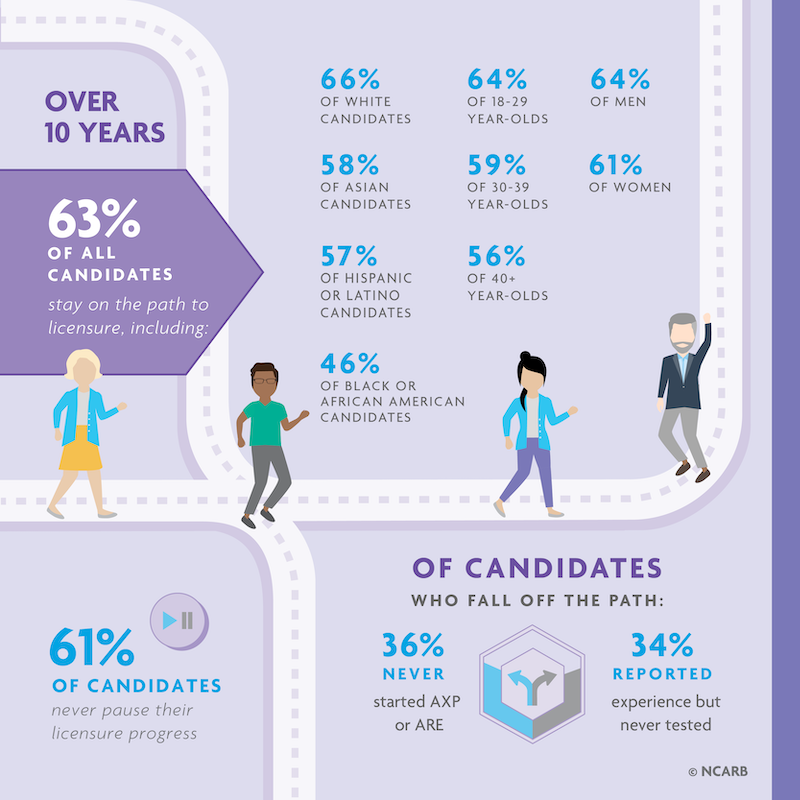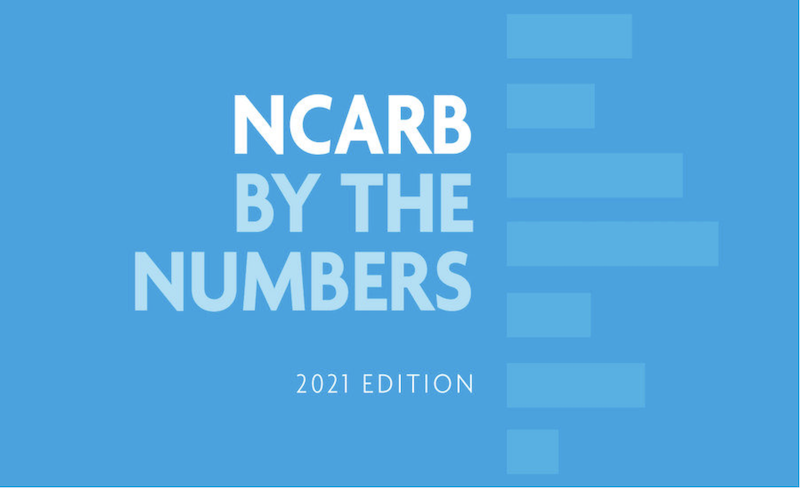On its 10th year of publishing information about its licensing exams, the National Council of Architectural Registration Boards (NCARB) for the first time has released a new section in the 2021 edition of its Architect Registration Examination that breaks down the pass rate by several demographic categories.
The six-part exam is required by all 55 NCARB jurisdictions in the U.S. for candidates seeking architectural licensure. More than 32,700 people took the test, and here are some of the key findings:
•White candidates’ pass rate is higher than that of candidates of color. The disparity is most pronounced in the Programming & Analysis division of the test that focuses on evaluating a project’s requirements and constraints; white candidates’ pass rate was 38 percentage points higher than their Black peers’.
•Men, in general, outperform women candidates on five of the exam’s six divisions. When factoring in race and ethnicity, Black women fare better on the test than Black male candidates.
•Candidates ages 18-29 have the highest pass rates across all six divisions. Candidates 40 years or older have the lowest rate.
Alfred Vidaurri Jr., FAIA, NCARB, AICP, who was inducted as NCARB’s president in June, stated that the findings were both unsurprising and unacceptable. “I challenge us to do better” he said of the industry, adding that he would concentrate on addressing these disparities during his tenure leading the organization.
The hardest part is getting some candidate groups to the finish line. NCARB reports that 63% of all candidates stay on their paths to licensure over 10 years, but that drops off to 61% for women candidates, 58% for Asian candidates, 57% for Hispanics, and 46% for Blacks.
NCARB WILL OFFER FREE PRACTICE TESTS

The report cites disparities in the rate of candidates pursuing licensure.
After commissioning an independent bias study of its exam, NCARB concluded that individual questions don’t drive disparities in candidates’ performance, and that the organization alone can’t resolve inequity in exam access and performance. “Coupled with NCARB’s data on career attrition, these studies suggest that pass rate disparities could also be impacted by access to education and professional experiences,” the organization stated.
Nevertheless, NCARB’s teams have been working to understand the causation of testing disparities, and the organization has pledged to launch the following changes, resources, and opportunities for feedback:
•For the first time in NCARB history, exam candidates have been appointed to the 2021 Examination Committee, which is responsible for recommending format and policy changes to NCARB’s national Board of Directors.
•NCARB is developing free practice tests for all six divisions, with a goal of offering the new suite of resources in mid-2022. (According to NCARB and the National Organization of Minority Architects’ joint Baseline on Belonging study, nearly half of respondents spent more than $500 on test prep materials.)
•NCARB is currently conducting another external audit of its exam, this time focused on the content areas to identify potential trends related to disparate pass rates.
•In addition to NCARB’s annual Think Tanks for emerging professionals and the upcoming Analysis of Practice study, the organization will launch two outreach initiatives in 2021-2022: licensure candidate focus groups conducted by an external consultant; and an Architecture Licensing Feedback survey, where the architect community can share their experience and recommendations.
•In 2019, NCARB launched an internal work group and commissioned external consultants to study licensure programs through an Equality, Diversity, and Inclusion lens. This effort is currently exploring potential links between exam performance and the criteria driving candidates’ Architectural Experience Program® (AXP®) reports, as well as firm culture.
The organization intends to release more details about these initiatives in the coming months.
Related Stories
Architects | Mar 5, 2024
Riken Yamamoto wins 2024 Pritzker Architecture Prize
The Pritzker Architecture Prize announces Riken Yamamoto, of Yokohama, Japan, as the 2024 Laureate of the Pritzker Architecture Prize, the award that is regarded internationally as architecture’s highest honor.
Office Buildings | Mar 5, 2024
Former McDonald’s headquarters transformed into modern office building for Ace Hardware
In Oak Brook, Ill., about 15 miles west of downtown Chicago, McDonald’s former corporate headquarters has been transformed into a modern office building for its new tenant, Ace Hardware. Now for the first time, Ace Hardware can bring 1,700 employees from three facilities under one roof.
Green | Mar 5, 2024
New York City’s Green Economy Action Plan aims for building decarbonization
New York City’s recently revealed Green Economy Action Plan includes the goals of the decarbonization of buildings and developing a renewable energy system. The ambitious plan includes enabling low-carbon alternatives in the transportation sector and boosting green industries, aiming to create more than 12,000 green economy apprenticeships by 2040.
Lighting | Mar 4, 2024
Illuminating your path to energy efficiency
Design Collaborative's Kelsey Rowe, PE, CLD, shares some tools, resources, and next steps to guide you through the process of lighting design.
MFPRO+ News | Mar 1, 2024
Housing affordability, speed of construction are top of mind for multifamily architecture and construction firms
The 2023 Multifamily Giants get creative to solve the affordability crisis, while helping their developer clients build faster and more economically.
Multifamily Housing | Feb 29, 2024
Manny Gonzalez, FAIA, inducted into Best in American Living Awards Hall of Fame
Manny Gonzalez, FAIA, has been inducted into the BALA Hall of Fame.
K-12 Schools | Feb 29, 2024
Average age of U.S. school buildings is just under 50 years
The average age of a main instructional school building in the United States is 49 years, according to a survey by the National Center for Education Statistics (NCES). About 38% of schools were built before 1970. Roughly half of the schools surveyed have undergone a major building renovation or addition.
MFPRO+ Research | Feb 28, 2024
New download: BD+C's 2023 Multifamily Amenities report
New research from Building Design+Construction and Multifamily Pro+ highlights the 127 top amenities that developers, property owners, architects, contractors, and builders are providing in today’s apartment, condominium, student housing, and senior living communities.
AEC Tech | Feb 28, 2024
How to harness LIDAR and BIM technology for precise building data, equipment needs
By following the Scan to Point Cloud + Point Cloud to BIM process, organizations can leverage the power of LIDAR and BIM technology at the same time. This optimizes the documentation of existing building conditions, functions, and equipment needs as a current condition and as a starting point for future physical plant expansion projects.
Data Centers | Feb 28, 2024
What’s next for data center design in 2024
Nuclear power, direct-to-chip liquid cooling, and data centers as learning destinations are among the emerging design trends in the data center sector, according to Scott Hays, Sector Leader, Sustainable Design, with HED.
















